Low-Pressure Plasma-Processed NiCo Metal–Organic Framework for Oxygen Evolution Reaction and Its Application in Alkaline Water Electrolysis Module
Abstract
:1. Introduction
2. Experimental
2.1. Synthesis of NiCo-MOF/NF Electrocatalyst
2.2. Synthesis of NiCo/CP and Ru/CP Electrocatalyst
2.3. Anion Exchange Membrane Alkaline Water Electrolysis Module
2.4. Material Characterization
2.5. Electrochemical Measurement
3. Results and Discussion
3.1. SEM Results of Electrocatalysts
3.2. Water Contact Angles of Grown Electrocatalysts
3.3. XPS and XRD
3.4. Electrochemical Characterization
3.5. Performance of Alkaline Water Electrolyzer
4. Conclusions
Supplementary Materials
Author Contributions
Funding
Data Availability Statement
Conflicts of Interest
References
- Wang, W.; Xu, X.; Zhou, W.; Shao, Z. Recent progress in metal-organic frameworks for applications in electrocatalytic and photocatalytic water splitting. Adv. Sci. 2017, 4, 1600371. [Google Scholar] [CrossRef] [PubMed]
- Cheng, F.; Zhang, T.; Zhang, Y.; Du, J.; Han, X.; Chen, J. Enhancing electrocatalytic oxygen reduction on MnO2 with vacancies. Angew. Chem. 2013, 125, 2534–2537. [Google Scholar] [CrossRef]
- Seh, Z.W.; Kibsgaard, J.; Dickens, C.F.; Chorkendorff, I.; Nørskov, J.K.; Jaramillo, T.F. Combining theory and experiment in electrocatalysis: Insights into materials design. Science 2017, 355, eaad4998. [Google Scholar] [CrossRef]
- Sun, H.; Zhang, W.; Li, J.-G.; Li, Z.; Ao, X.; Xue, K.-H.; Ostrikov, K.K.; Tang, J.; Wang, C. Rh-engineered ultrathin NiFe-LDH nanosheets enable highly-efficient overall water splitting and urea electrolysis. Appl. Catal. B Environ. 2021, 284, 119740. [Google Scholar] [CrossRef]
- Du, X.; Ma, G.; Zhang, X. Experimental and theoretical understanding on electrochemical activation processes of nickel selenide for excellent water-splitting performance: Comparing the electrochemical performances with M–NiSe (M = Co, Cu, and V). ACS Sustain. Chem. Eng. 2019, 7, 19257–19267. [Google Scholar] [CrossRef]
- Yu, L.; Lei, T.; Nan, B.; Jiang, Y.; He, Y.; Liu, C. Characteristics of a sintered porous Ni–Cu alloy cathode for hydrogen production in a potassium hydroxide solution. Energy 2016, 97, 498–505. [Google Scholar] [CrossRef]
- Wu, Y.; Lian, J.; Wang, Y.; Sun, J.; He, Z.; Gu, Z. Potentiostatic electrodeposition of self-supported NiS electrocatalyst supported on Ni foam for efficient hydrogen evolution. Mater. Des. 2021, 198, 109316. [Google Scholar] [CrossRef]
- Suen, N.-T.; Hung, S.-F.; Quan, Q.; Zhang, N.; Xu, Y.-J.; Chen, H.M. Electrocatalysis for the oxygen evolution reaction: Recent development and future perspectives. Chem. Soc. Rev. 2017, 46, 337–365. [Google Scholar] [CrossRef]
- Tian, X.; Zhao, X.; Su, Y.-Q.; Wang, L.; Wang, H.; Dang, D.; Chi, B.; Liu, H.; Hensen, E.J.; Lou, X.W. Engineering bunched Pt-Ni alloy nanocages for efficient oxygen reduction in practical fuel cells. Science 2019, 366, 850–856. [Google Scholar] [CrossRef]
- Maeda, K.; Teramura, K.; Lu, D.; Takata, T.; Saito, N.; Inoue, Y.; Domen, K. Photocatalyst releasing hydrogen from water. Nature 2006, 440, 295. [Google Scholar] [CrossRef]
- Tang, C.; Zhang, R.; Lu, W.; He, L.; Jiang, X.; Asiri, A.M.; Sun, X. Fe-doped CoP nanoarray: A monolithic multifunctional catalyst for highly efficient hydrogen generation. Adv. Mater. 2017, 29, 1602441. [Google Scholar] [CrossRef] [PubMed]
- Ahmed, Z.; Ahmad, M.; Murshed, M.; Shah, M.I.; Mahmood, H.; Abbas, S. How do green energy technology investments, technological innovation, and trade globalization enhance green energy supply and stimulate environmental sustainability in the G7 countries? Gondwana Res. 2022, 112, 105–115. [Google Scholar] [CrossRef]
- Santos, D.M.; Sequeira, C.A.; Figueiredo, J.L. Hydrogen production by alkaline water electrolysis. Química Nova 2013, 36, 1176–1193. [Google Scholar] [CrossRef]
- Rashid, M.; Al Mesfer, M.K.; Naseem, H.; Danish, M. Hydrogen production by water electrolysis: A review of alkaline water electrolysis, PEM water electrolysis and high temperature water electrolysis. Int. J. Eng. Adv. Technol. 2015, 4, 80. [Google Scholar]
- Hall, D. Electrodes for alkaline water electrolysis. J. Electrochem. Soc. 1981, 128, 740. [Google Scholar] [CrossRef]
- Ma, S.; Sadakiyo, M.; Luo, R.; Heima, M.; Yamauchi, M.; Kenis, P.J. One-step electrosynthesis of ethylene and ethanol from CO2 in an alkaline electrolyzer. J. Power Sources 2016, 301, 219–228. [Google Scholar] [CrossRef]
- LeRoy, R. Industrial water electrolysis: Present and future. Int. J. Hydrogen Energy 1983, 8, 401–417. [Google Scholar] [CrossRef]
- Fang, Y.-H.; Liu, Z.-P. Mechanism and tafel lines of electro-oxidation of water to oxygen on RuO2 (110). J. Am. Chem. Soc. 2010, 132, 18214–18222. [Google Scholar] [CrossRef]
- Zhao, M.; Wang, Y.; Ma, Q.; Huang, Y.; Zhang, X.; Ping, J.; Zhang, Z.; Lu, Q.; Yu, Y.; Xu, H. Ultrathin 2D metal–organic framework nanosheets. Adv. Mater. 2015, 27, 7372–7378. [Google Scholar] [CrossRef]
- Ensafi, A.A.; Nabiyan, A.; Jafari-Asl, M.; Dinari, M.; Farrokhpour, H.; Rezaei, B. Galvanic exchange at layered doubled hydroxide/N-doped graphene as an in-situ method to fabricate powerful electrocatalysts for hydrogen evolution reaction. Energy 2016, 116, 1087–1096. [Google Scholar] [CrossRef]
- Lyons, M.E.; Brandon, M.P. The oxygen evolution reaction on passive oxide covered transition metal electrodes in aqueous alkaline solution. Part 1-Nickel. Int. J. Electrochem. Sci. 2008, 3, 1386–1424. [Google Scholar] [CrossRef]
- Hall, D.S.; Lockwood, D.J.; Bock, C.; MacDougall, B.R. Nickel hydroxides and related materials: A review of their structures, synthesis and properties. Proc. R. Soc. A Math. Phys. Eng. Sci. 2015, 471, 20140792. [Google Scholar] [CrossRef] [PubMed]
- Ishaq, H.; Dincer, I.; Crawford, C. A review on hydrogen production and utilization: Challenges and opportunities. Int. J. Hydrogen Energy 2022, 47, 26238–26264. [Google Scholar] [CrossRef]
- Pareek, A.; Dom, R.; Gupta, J.; Chandran, J.; Adepu, V.; Borse, P.H. Insights into renewable hydrogen energy: Recent advances and prospects. Mater. Sci. Energy Technol. 2020, 3, 319–327. [Google Scholar] [CrossRef]
- Zhou, D.; Li, P.; Xu, W.; Jawaid, S.; Mohammed-Ibrahim, J.; Liu, W.; Kuang, Y.; Sun, X. Recent advances in non-precious metal-based electrodes for alkaline water electrolysis. ChemNanoMat 2020, 6, 336–355. [Google Scholar] [CrossRef]
- Liu, D.; Xu, H.; Wang, C.; Shang, H.; Yu, R.; Wang, Y.; Li, J.; Li, X.; Du, Y. 3D porous Ru-doped NiCo-MOF hollow nanospheres for boosting oxygen evolution reaction electrocatalysis. Inorg. Chem. 2021, 60, 5882–5889. [Google Scholar] [CrossRef] [PubMed]
- Feng, J.X.; Xu, H.; Dong, Y.T.; Ye, S.H.; Tong, Y.X.; Li, G.R. FeOOH/Co/FeOOH hybrid nanotube arrays as high-performance electrocatalysts for the oxygen evolution reaction. Angew. Chem. Int. Ed. 2016, 55, 3694–3698. [Google Scholar] [CrossRef]
- Tran, T.Q.N.; Das, G.; Yoon, H.H. Nickel-metal organic framework/MWCNT composite electrode for non-enzymatic urea detection. Sens. Actuators B Chem. 2017, 243, 78–83. [Google Scholar] [CrossRef]
- Cheng, Y.; Xiao, X.; Guo, X.; Yao, H.; Pang, H. Synthesis of “Quasi-Ce-MOF” electrocatalysts for enhanced urea oxidation reaction performance. ACS Sustain. Chem. Eng. 2020, 8, 8675–8680. [Google Scholar] [CrossRef]
- Amouzesh, S.P.; Khodadadi, A.A.; Mortazavi, Y.; Saris, S.; Asgari, M. MIL-100 (Fe)/ZnO nanocomposite sensors: An enhanced ammonia selectivity and low operating temperature. Sens. Actuators B Chem. 2024, 399, 134791. [Google Scholar] [CrossRef]
- Bibi, S.; Pervaiz, E.; Ali, M. Synthesis and applications of metal oxide derivatives of ZIF-67: A mini-review. Chem. Pap. 2021, 75, 2253–2275. [Google Scholar] [CrossRef]
- Zhang, S.; Luo, J.; Dai, L.; Zhou, S.; Tang, T.; Ai, S. NiCoP self-supporting electrode with the sea urchin-like microstructure for the synchronous reaction of hydrogen evolution and contaminant degradation. J. Electroanal. Chem. 2021, 891, 115273. [Google Scholar] [CrossRef]
- Li, W.; Gao, X.; Wang, X.; Xiong, D.; Huang, P.-P.; Song, W.-G.; Bao, X.; Liu, L. From water reduction to oxidation: Janus Co-Ni-P nanowires as high-efficiency and ultrastable electrocatalysts for over 3000 h water splitting. J. Power Sources 2016, 330, 156–166. [Google Scholar] [CrossRef]
- Li, L.; Li, X.; Ai, L.; Jiang, J. MOF-derived nanostructured cobalt phosphide assemblies for efficient hydrogen evolution reaction. RSC Adv. 2015, 5, 90265–90271. [Google Scholar] [CrossRef]
- Zhou, X.; Xia, Z.; Zhang, Z.; Ma, Y.; Qu, Y. One-step synthesis of multi-walled carbon nanotubes/ultra-thin Ni(OH)2 nanoplate composite as efficient catalysts for water oxidation. J. Mater. Chem. A 2014, 2, 11799–11806. [Google Scholar] [CrossRef]
- Zhu, W.; Yue, X.; Zhang, W.; Yu, S.; Zhang, Y.; Wang, J.; Wang, J. Nickel sulfide microsphere film on Ni foam as an efficient bifunctional electrocatalyst for overall water splitting. Chem. Commun. 2016, 52, 1486–1489. [Google Scholar] [CrossRef]
- Yu, X.-Y.; Feng, Y.; Guan, B.; Lou, X.W.D.; Paik, U. Carbon coated porous nickel phosphides nanoplates for highly efficient oxygen evolution reaction. Energy Environ. Sci. 2016, 9, 1246–1250. [Google Scholar] [CrossRef]
- Thangasamy, P.; Shanmuganathan, S.; Subramanian, V. A NiCo-MOF nanosheet array based electrocatalyst for the oxygen evolution reaction. Nanoscale Adv. 2020, 2, 2073–2079. [Google Scholar] [CrossRef]
- Guan, H.; Wang, N.; Feng, X.; Bian, S.; Liu, Y.; Ma, M.; Li, W.; Chen, Y. S element-doped synergistically well-mixed MOFs as highly efficient oxygen precipitation electrocatalyst. Int. J. Hydrogen Energy 2020, 45, 24333–24340. [Google Scholar] [CrossRef]
- Dou, S.; Tao, L.; Wang, R.; El Hankari, S.; Chen, R.; Wang, S. Plasma-assisted synthesis and surface modification of electrode materials for renewable energy. Adv. Mater. 2018, 30, 1705850. [Google Scholar] [CrossRef]
- Mistry, H.; Varela, A.S.; Bonifacio, C.S.; Zegkinoglou, I.; Sinev, I.; Choi, Y.-W.; Kisslinger, K.; Stach, E.A.; Yang, J.C.; Strasser, P. Highly selective plasma-activated copper catalysts for carbon dioxide reduction to ethylene. Nat. Commun. 2016, 7, 12123. [Google Scholar] [CrossRef] [PubMed]
- Wang, Z.; Zhang, Y.; Neyts, E.C.; Cao, X.; Zhang, X.; Jang, B.W.-L.; Liu, C.-J. Catalyst preparation with plasmas: How does it work? ACS Catal. 2018, 8, 2093–2110. [Google Scholar] [CrossRef]
- Yan, D.; Li, Y.; Huo, J.; Chen, R.; Dai, L.; Wang, S. Defect chemistry of nonprecious-metal electrocatalysts for oxygen reactions. Adv. Mater. 2017, 29, 1606459. [Google Scholar] [CrossRef]
- Yu, Z.Y.; Duan, Y.; Feng, X.Y.; Yu, X.; Gao, M.R.; Yu, S.H. Clean and affordable hydrogen fuel from alkaline water splitting: Past, recent progress, and future prospects. Adv. Mater. 2021, 33, 2007100. [Google Scholar] [CrossRef] [PubMed]
- Tao, L.; Duan, X.; Wang, C.; Duan, X.; Wang, S. Plasma-engineered MoS 2 thin-film as an efficient electrocatalyst for hydrogen evolution reaction. Chem. Commun. 2015, 51, 7470–7473. [Google Scholar] [CrossRef] [PubMed]
- Zhang, T.; Wu, J.; Chen, J.; Pan, Q.; Wang, X.; Zhong, H.; Tao, R.; Yan, J.; Hu, Y.; Ye, X. Activating titanium metal with H2 plasma for the hydrogen evolution reaction. ACS Appl. Mater. Interfaces 2021, 13, 24682–24691. [Google Scholar] [CrossRef] [PubMed]
- Liu, C.; Tseng, C.-Y.; Wang, Y.-C.; Cheng, I.-C.; Chen, J.-Z. Low-Pressure Plasma-Processed Ruthenium/Nickel Foam Electrocatalysts for Hydrogen Evolution Reaction. Materials 2022, 15, 2603. [Google Scholar] [CrossRef]
- Tseng, C.-Y.; Cheng, I.-C.; Chen, J.-Z. Low-pressure-plasma-processed NiFe-MOFs/nickel foam as an efficient electrocatalyst for oxygen evolution reaction. Int. J. Hydrogen Energy 2022, 47, 35990–35998. [Google Scholar] [CrossRef]
- Xu, L.; Jiang, Q.; Xiao, Z.; Li, X.; Huo, J.; Wang, S.; Dai, L. Plasma-engraved Co3O4 nanosheets with oxygen vacancies and high surface area for the oxygen evolution reaction. Angew. Chem. 2016, 128, 5363–5367. [Google Scholar] [CrossRef]
- Wang, Y.; Zhou, T.; Jiang, K.; Da, P.; Peng, Z.; Tang, J.; Kong, B.; Cai, W.B.; Yang, Z.; Zheng, G. Reduced mesoporous Co3O4 nanowires as efficient water oxidation electrocatalysts and supercapacitor electrodes. Adv. Energy Mater. 2014, 4, 1400696. [Google Scholar] [CrossRef]
- Zhu, K.; Shi, F.; Zhu, X.; Yang, W. The roles of oxygen vacancies in electrocatalytic oxygen evolution reaction. Nano Energy 2020, 73, 104761. [Google Scholar] [CrossRef]
- Lotfi, N.; Shahrabi, T.; Yaghoubinezhad, Y.; Darband, G.B. Electrodeposition of cedar leaf-like graphene Oxide@ Ni–Cu@ Ni foam electrode as a highly efficient and ultra-stable catalyst for hydrogen evolution reaction. Electrochim. Acta 2019, 326, 134949. [Google Scholar] [CrossRef]
- Chen, D.; Liu, Z. Dual-axial gradient doping (Zr and Sn) on hematite for promoting charge separation in photoelectrochemical water splitting. ChemSusChem 2018, 11, 3438–3448. [Google Scholar] [CrossRef] [PubMed]
- Fujimura, T.; Hikima, W.; Fukunaka, Y.; Homma, T. Analysis of the effect of surface wettability on hydrogen evolution reaction in water electrolysis using micro-patterned electrodes. Electrochem. Commun. 2019, 101, 43–46. [Google Scholar] [CrossRef]
- Lu, Z.; Zhu, W.; Yu, X.; Zhang, H.; Li, Y.; Sun, X.; Wang, X.; Wang, H.; Wang, J.; Luo, J. Ultrahigh hydrogen evolution performance of under-water “superaerophobic” MoS2 nanostructured electrodes. Adv. Mater. 2014, 26, 2683–2687. [Google Scholar] [CrossRef] [PubMed]
- Santos, D.; Šljukić, B.; Sequeira, C.; Macciò, D.; Saccone, A.; Figueiredo, J. Electrocatalytic approach for the efficiency increase of electrolytic hydrogen production: Proof-of-concept using platinum–dysprosium alloys. Energy 2013, 50, 486–492. [Google Scholar] [CrossRef]
- Veeramani, V.; Madhu, R.; Chen, S.-M.; Sivakumar, M.; Hung, C.-T.; Miyamoto, N.; Liu, S.-B. NiCo2O4-decorated porous carbon nanosheets for high-performance supercapacitors. Electrochim. Acta 2017, 247, 288–295. [Google Scholar] [CrossRef]
- Chen, Q.; Lei, S.; Deng, P.; Ou, X.; Chen, L.; Wang, W.; Xiao, Y.; Cheng, B. Direct growth of nickel terephthalate on Ni foam with large mass-loading for high-performance supercapacitors. J. Mater. Chem. A 2017, 5, 19323–19332. [Google Scholar] [CrossRef]
- Gopalakrishnan, M.; Mohamad, A.; Nguyen, M.; Yonezawa, T.; Qin, J.; Thamyongkit, P.; Somwangthanaroj, A.; Kheawhom, S. Recent advances in oxygen electrocatalysts based on tunable structural polymers. Mater. Today Chem. 2022, 23, 100632. [Google Scholar] [CrossRef]
- Liang, Q.; Chen, J.; Wang, F.; Li, Y. Transition metal-based metal-organic frameworks for oxygen evolution reaction. Coord. Chem. Rev. 2020, 424, 213488. [Google Scholar] [CrossRef]
- Tahir, M.; Pan, L.; Idrees, F.; Zhang, X.; Wang, L.; Zou, J.-J.; Wang, Z.L. Electrocatalytic oxygen evolution reaction for energy conversion and storage: A comprehensive review. Nano Energy 2017, 37, 136–157. [Google Scholar] [CrossRef]
- Fu, H.Q.; Zhou, M.; Liu, P.F.; Liu, P.; Yin, H.; Sun, K.Z.; Yang, H.G.; Al-Mamun, M.; Hu, P.; Wang, H.-F. Hydrogen spillover-bridged Volmer/Tafel processes enabling ampere-level current density alkaline hydrogen evolution reaction under low overpotential. J. Am. Chem. Soc. 2022, 144, 6028–6039. [Google Scholar] [CrossRef] [PubMed]
- Dai, Z.; Du, X.; Zhang, X. Controlled synthesis of NiCo2O4@ Ni-MOF on Ni foam as efficient electrocatalyst for urea oxidation reaction and oxygen evolution reaction. Int. J. Hydrogen Energy 2022, 47, 17252–17262. [Google Scholar] [CrossRef]
- Kapałka, A.; Fóti, G.; Comninellis, C. Determination of the Tafel slope for oxygen evolution on boron-doped diamond electrodes. Electrochem. Commun. 2008, 10, 607–610. [Google Scholar] [CrossRef]
- Shinagawa, T.; Garcia-Esparza, A.T.; Takanabe, K. Insight on Tafel slopes from a microkinetic analysis of aqueous electrocatalysis for energy conversion. Sci. Rep. 2015, 5, 13801. [Google Scholar] [CrossRef] [PubMed]
- Zhang, Y.; Cui, W.; Li, L.; Zhan, C.; Xiao, F.; Quan, X. Effect of aligned porous electrode thickness and pore size on bubble removal capability and hydrogen evolution reaction performance. J. Power Sources 2023, 580, 233380. [Google Scholar] [CrossRef]
- Wu, L.; He, Y.; Lei, T.; Nan, B.; Xu, N.; Zou, J.; Huang, B.; Liu, C. Characterization of the porous Ni3Al–Mo electrodes during hydrogen generation from alkaline water electrolysis. Energy 2013, 63, 216–224. [Google Scholar] [CrossRef]
- Li, D.; Xu, Y.; Lu, Y.; Chen, Y.; Wu, Y.; Yan, J.; Du, F.; Zhao, Y.; Tan, X. Defect-rich engineering of Ni-incorporated tungsten oxides micro-flowers on carbon cloth: A binder-free electrode for highly efficient hydrogen evolution reaction. J. Power Sources 2022, 520, 230862. [Google Scholar] [CrossRef]
- Shervedani, R.K.; Madram, A.R. Kinetics of hydrogen evolution reaction on nanocrystalline electrodeposited Ni62Fe35C3 cathode in alkaline solution by electrochemical impedance spectroscopy. Electrochim. Acta 2007, 53, 426–433. [Google Scholar] [CrossRef]
- Cossar, E.; Houache, M.S.; Zhang, Z.; Baranova, E.A. Comparison of electrochemical active surface area methods for various nickel nanostructures. J. Electroanal. Chem. 2020, 870, 114246. [Google Scholar] [CrossRef]
- Yang, Y.; Zhang, W.; Xiao, Y.; Shi, Z.; Cao, X.; Tang, Y.; Gao, Q. CoNiSe2 heteronanorods decorated with layered-double-hydroxides for efficient hydrogen evolution. Appl. Catal. B Environ. 2019, 242, 132–139. [Google Scholar] [CrossRef]
- Zhao, Z.; Wu, H.; Li, C. Engineering iron phosphide-on-plasmonic Ag/Au-nanoshells as an efficient cathode catalyst in water splitting for hydrogen production. Energy 2021, 218, 119520. [Google Scholar] [CrossRef]
- Liang, H.; Alshareef, H.N. A plasma-assisted route to the rapid preparation of transition-metal phosphides for energy conversion and storage. Small Methods 2017, 1, 1700111. [Google Scholar] [CrossRef]
- Choi, E.Y.; Moon, S.H. Characterization of acrylic acid-grafted PP membranes prepared by plasma-induced graft polymerization. J. Appl. Polym. Sci. 2007, 105, 2314–2320. [Google Scholar] [CrossRef]
- Staňo, Ľ.; Stano, M.; Ďurina, P. Separators for alkaline water electrolysis prepared by plasma-initiated grafting of acrylic acid on microporous polypropylene membranes. Int. J. Hydrogen Energy 2020, 45, 80–93. [Google Scholar] [CrossRef]
- Detsi, E.; Cook, J.B.; Lesel, B.K.; Turner, C.L.; Liang, Y.-L.; Robbennolt, S.; Tolbert, S.H. Mesoporous Ni6Fe30Mn10-alloy based metal/metal oxide composite thick films as highly active and robust oxygen evolution catalysts. Energy Environ. Sci. 2016, 9, 540–549. [Google Scholar] [CrossRef]
- Yin, H.; Zhao, S.; Zhao, K.; Muqsit, A.; Tang, H.; Chang, L.; Zhao, H.; Gao, Y.; Tang, Z. Ultrathin platinum nanowires grown on single-layered nickel hydroxide with high hydrogen evolution activity. Nat. Commun. 2015, 6, 6430. [Google Scholar] [CrossRef]
- Balogun, M.S.; Qiu, W.; Huang, Y.; Yang, H.; Xu, R.; Zhao, W.; Li, G.R.; Ji, H.; Tong, Y. Cost-Effective Alkaline Water Electrolysis Based on Nitrogen-and Phosphorus-Doped Self-Supportive Electrocatalysts. Adv. Mater. 2017, 29, 1702095. [Google Scholar] [CrossRef]
- Niyitanga, T.; Kim, H. Bimetallic-based CuxCo3− xO4 nanoparticle-embedded N-doped reduced graphene oxide toward efficient oxygen evolution reaction and hydrogen evolution reaction for bifunctional catalysis. J. Power Sources 2023, 580, 233383. [Google Scholar] [CrossRef]
- Osmieri, L.; He, Y.; Chung, H.T.; McCool, G.; Zulevi, B.; Cullen, D.A.; Zelenay, P. La–Sr–Co oxide catalysts for oxygen evolution reaction in anion exchange membrane water electrolyzer: The role of electrode fabrication on performance and durability. J. Power Sources 2023, 556, 232484. [Google Scholar] [CrossRef]
- Shen, X.; Zhang, X.; Li, G.; Lie, T.T.; Hong, L. Experimental study on the external electrical thermal and dynamic power characteristics of alkaline water electrolyzer. Int. J. Energy Res. 2018, 42, 3244–3257. [Google Scholar] [CrossRef]
- Mohammadi, A.; Mehrpooya, M. A comprehensive review on coupling different types of electrolyzer to renewable energy sources. Energy 2018, 158, 632–655. [Google Scholar] [CrossRef]
- Gilliam, R.; Graydon, J.; Kirk, D.; Thorpe, S. A review of specific conductivities of potassium hydroxide solutions for various concentrations and temperatures. Int. J. Hydrogen Energy 2007, 32, 359–364. [Google Scholar] [CrossRef]
- Kothari, R.; Buddhi, D.; Sawhney, R. Studies on the effect of temperature of the electrolytes on the rate of production of hydrogen. Int. J. Hydrogen Energy 2005, 30, 261–263. [Google Scholar] [CrossRef]
- Diéguez, P.; Ursúa, A.; Sanchis, P.; Sopena, C.; Guelbenzu, E.; Gandía, L. Thermal performance of a commercial alkaline water electrolyzer: Experimental study and mathematical modeling. Int. J. Hydrogen Energy 2008, 33, 7338–7354. [Google Scholar] [CrossRef]
- Shin, Y.; Park, W.; Chang, J.; Park, J. Evaluation of the high temperature electrolysis of steam to produce hydrogen. Int. J. Hydrogen Energy 2007, 32, 1486–1491. [Google Scholar] [CrossRef]
- Haynes, W.M. CRC Handbook of Chemistry and Physics; CRC Press: Boca Raton, FL, USA, 2014. [Google Scholar]
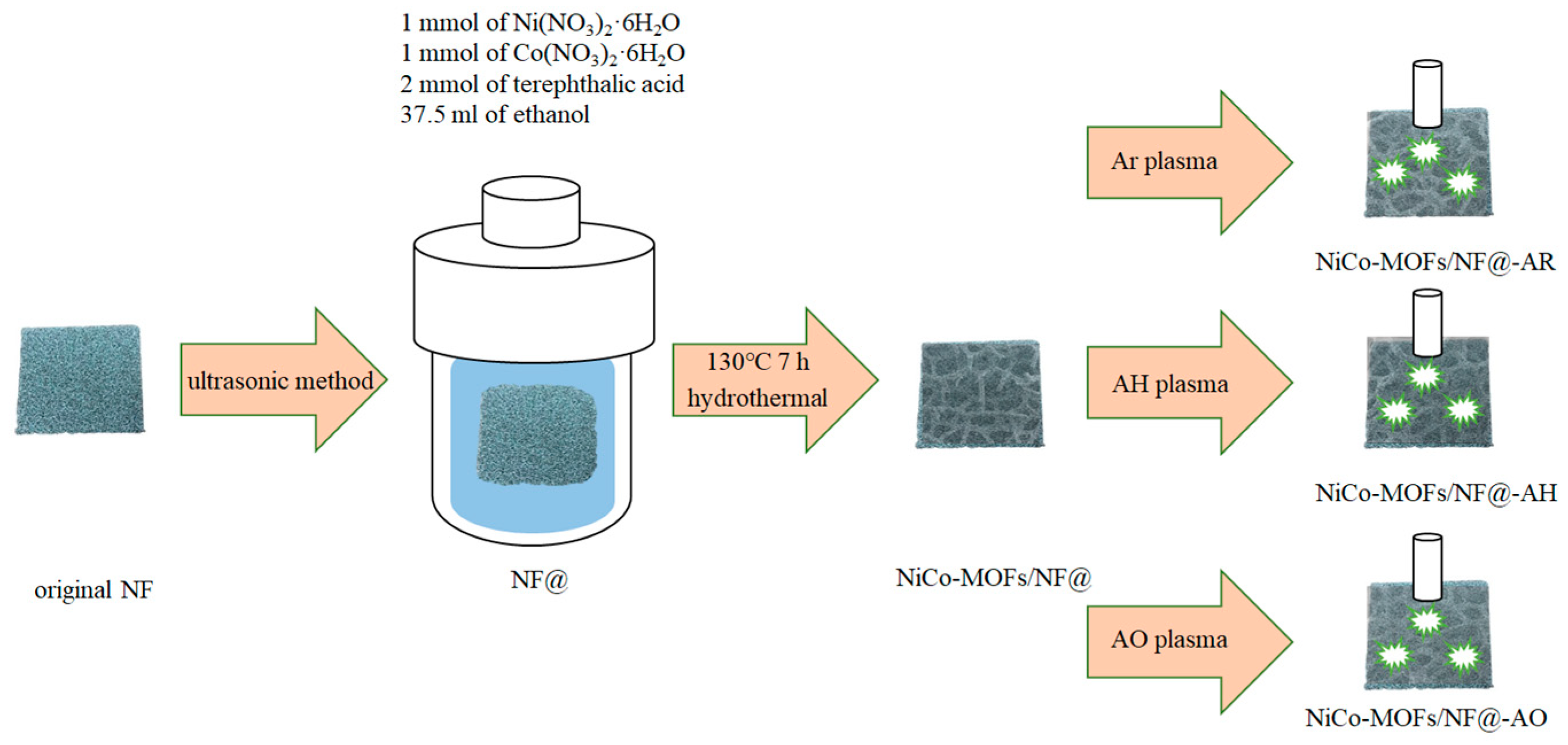
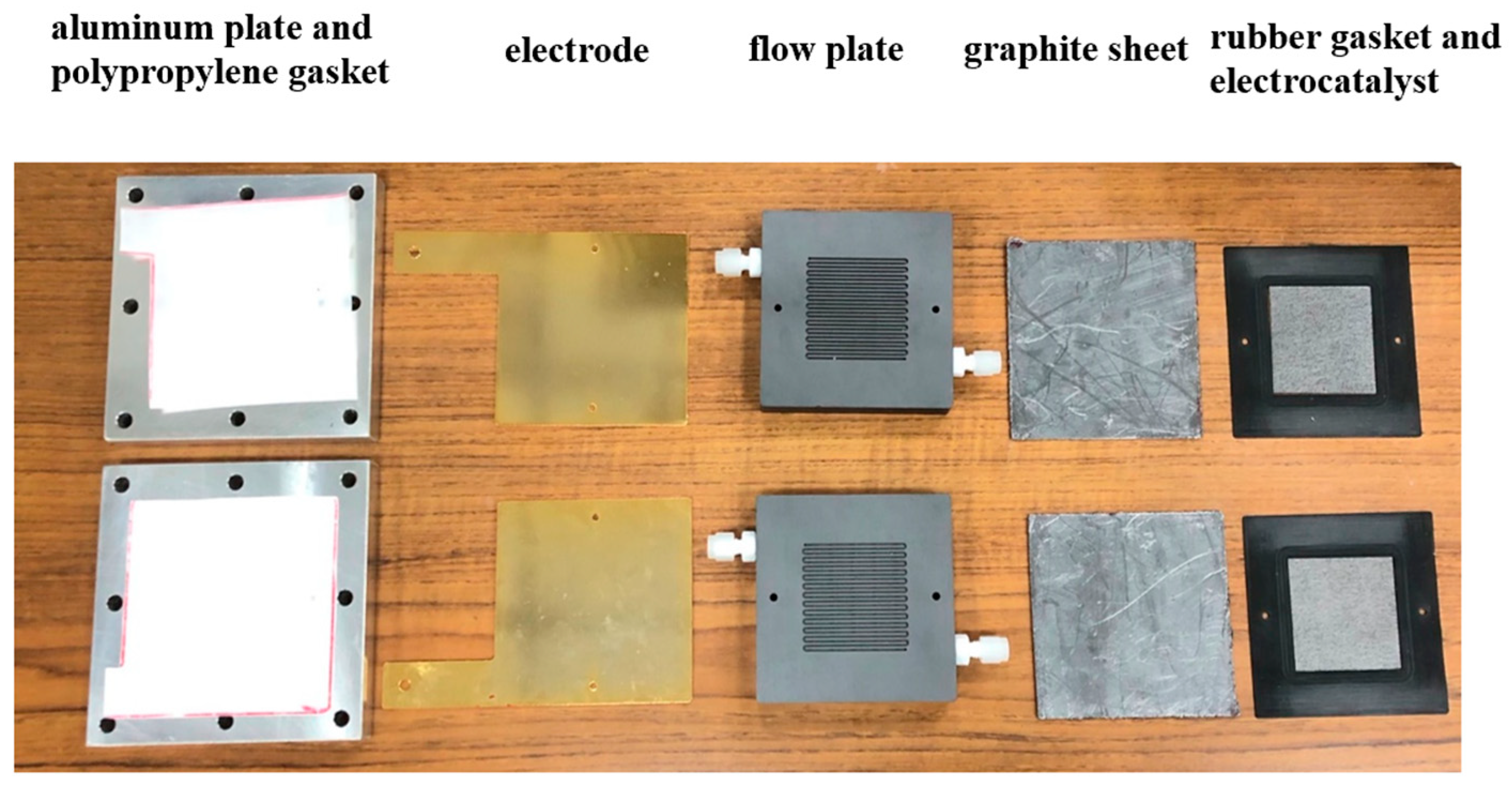


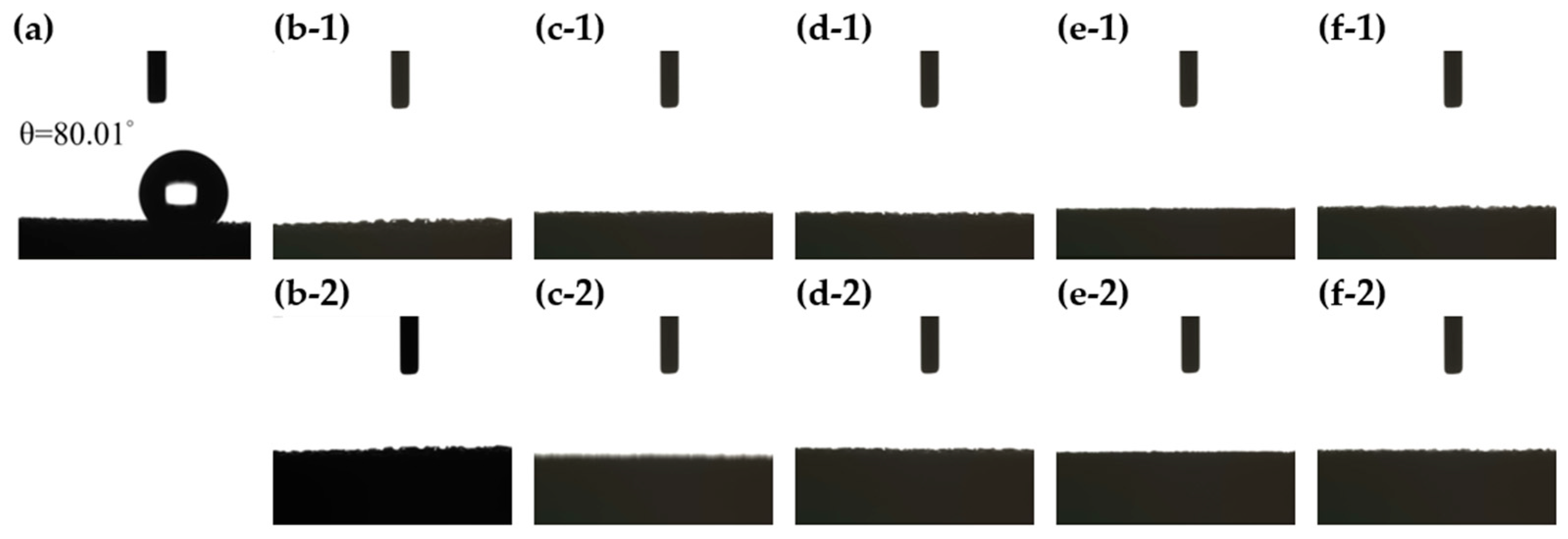
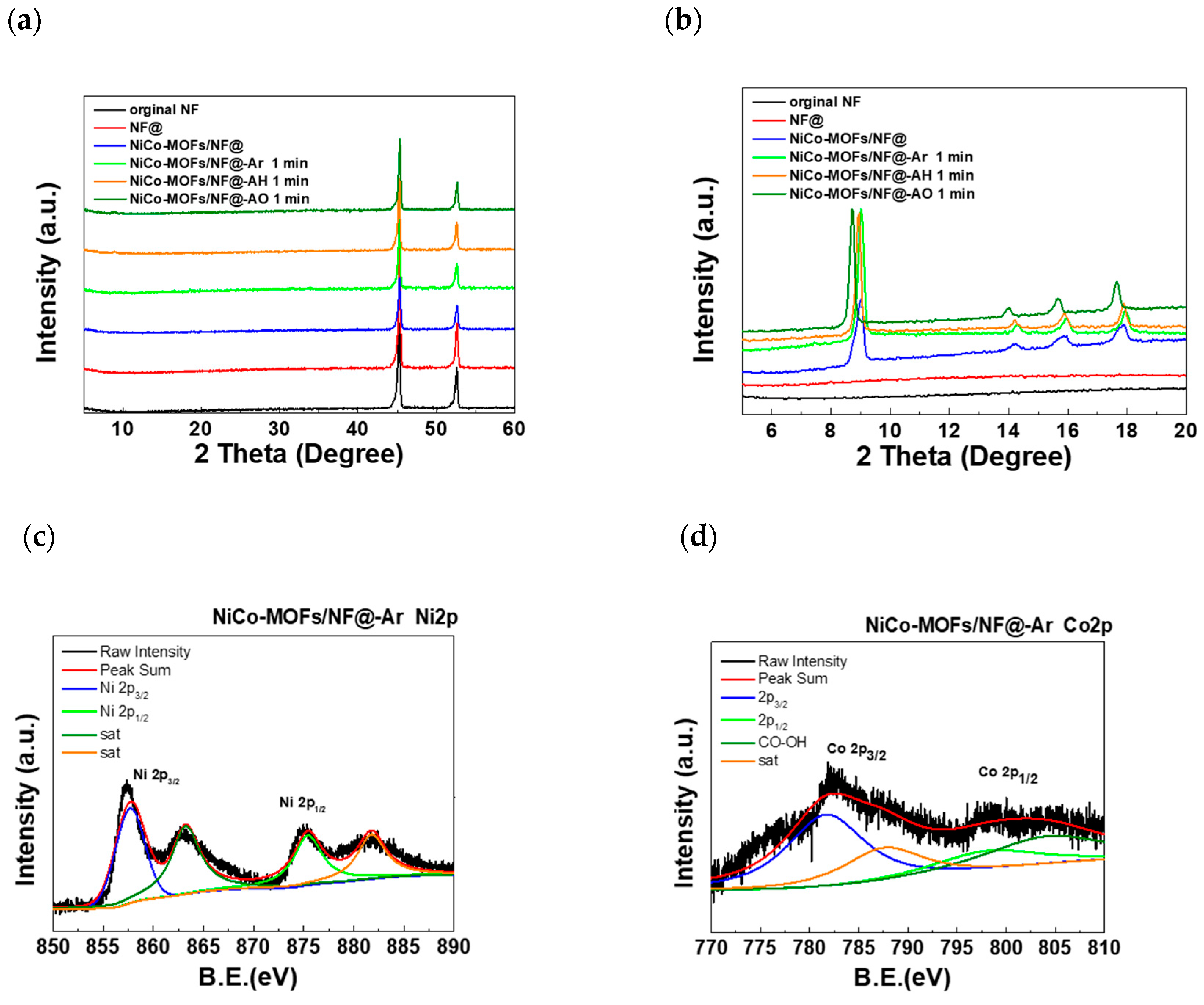
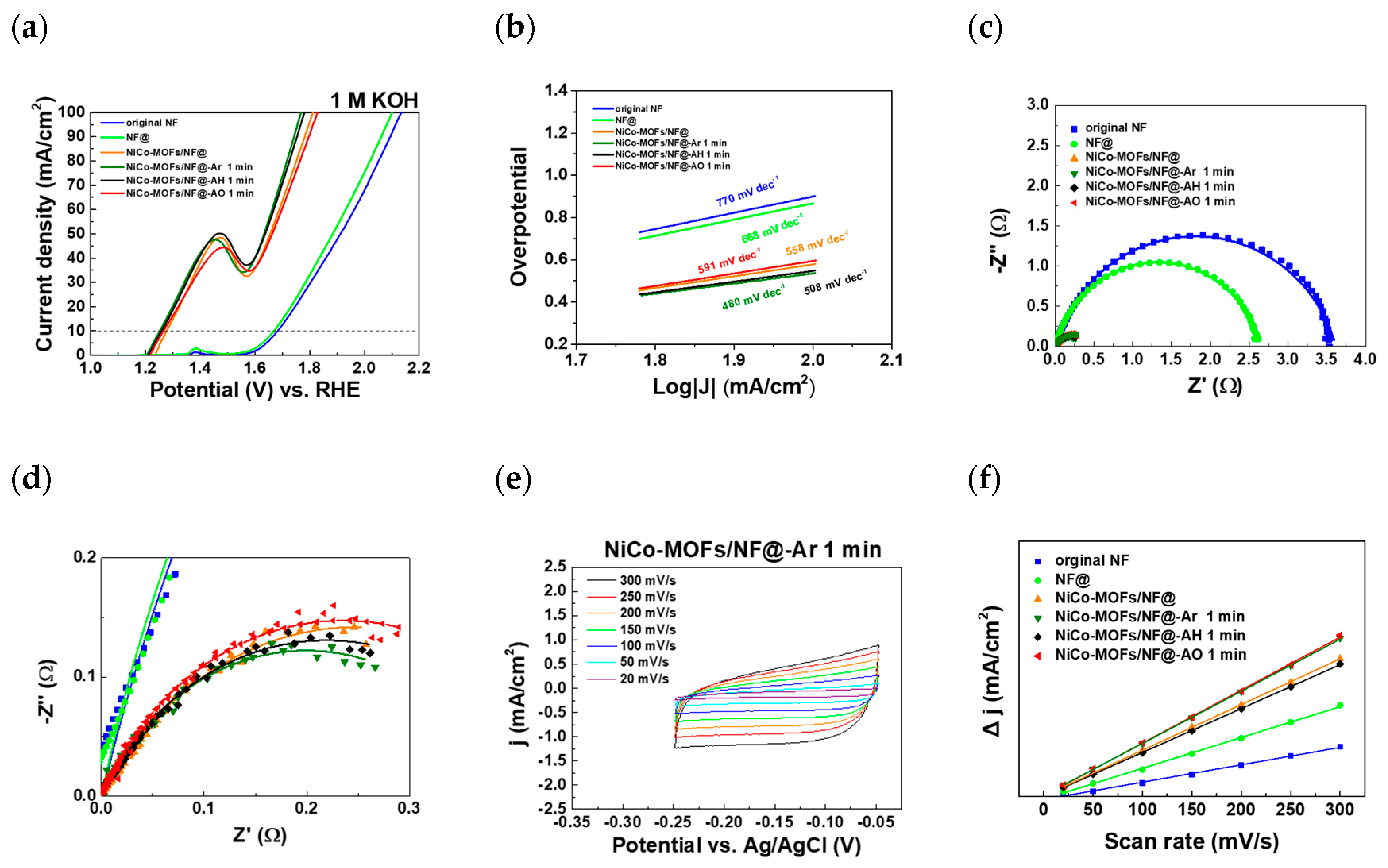
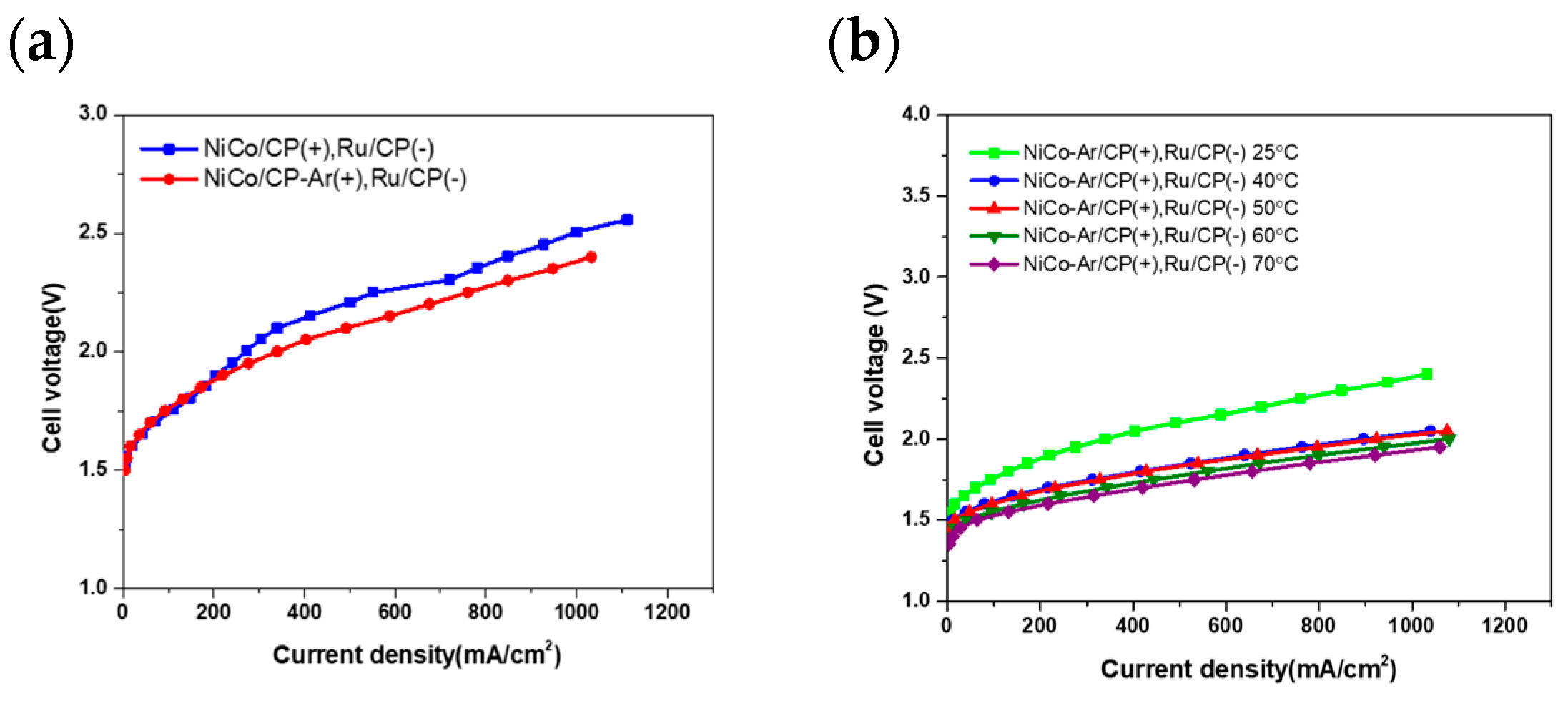
| Sample | Tafel Slope (mV/dec) | Overpotential (mV) at Current Density of 100 mA/cm2 | Rct (Ω) | 2Cdl (mF/cm2) |
|---|---|---|---|---|
| NF | 770 | 1906 | 3.61 | 1.7 |
| NF@ | 668 | 1871 | 2.64 | 3.0 |
| NiCo MOFs/NF@ | 558 | 584 | 0.50 | 4.5 |
| NiCo MOFs/NF@-Ar 1 min | 480 | 540 | 0.40 | 5.1 |
| NiCo MOFs/NF@-AH 1 min | 508 | 552 | 0.44 | 4.3 |
| NiCo MOFs/NF@-AO 1 min | 591 | 601 | 0.47 | 5.2 |
| Electrocatalysts | Current Density | Cell Voltage | Power Supply Voltage | H2 production Rate (Experimental) | O2 production Rate (Experimental) | Energy Efficiency | Specific Energy Consumption | |
|---|---|---|---|---|---|---|---|---|
| Unit | mA/cm2 | V | V | mL/min | mL/min | % | kWh/m3 | |
| NiCo/CP(+), Ru/CP(−) | 100 | 1.75 | 1.84 | 18 | 10 | 76.3 | 4.26 | |
| 500 | 2.21 | 2.68 | 94 | 49 | 54.7 | 5.94 | ||
| 1000 | 2.51 | 3.39 | 189 | 52 | 43.5 | 7.74 | ||
| NiCo/CP-Ar(+), Ru/CP(−) | 25 °C | 100 | 1.73 | 1.82 | 19 | 10 | 81.4 | 3.99 |
| 500 | 2.03 | 2.46 | 98.5 | 48 | 62.5 | 5.20 | ||
| 1000 | 2.3 | 3.16 | 199 | 97 | 49.1 | 6.62 | ||
| 40 °C | 100 | 1.62 | 1.71 | 19 | 10 | 86.7 | 3.75 | |
| 500 | 1.84 | 2.22 | 97 | 50 | 68.2 | 4.77 | ||
| 1000 | 2.04 | 2.87 | 198 | 101 | 53.8 | 6.04 | ||
| 50 °C | 100 | 1.61 | 1.66 | 19.5 | 10.5 | 91.6 | 3.55 | |
| 500 | 1.84 | 2.25 | 96.5 | 50.5 | 66.9 | 4.86 | ||
| 1000 | 2.03 | 2.90 | 196 | 100 | 52.7 | 6.16 | ||
| 60 °C | 100 | 1.56 | 1.62 | 19 | 10.5 | 91.5 | 3.55 | |
| 500 | 1.78 | 2.20 | 95 | 51 | 67.4 | 4.82 | ||
| 1000 | 1.98 | 2.81 | 192 | 101 | 53.3 | 6.10 | ||
| 70 °C | 100 | 1.53 | 1.61 | 19 | 10.5 | 92.0 | 3.53 | |
| 500 | 1.74 | 2.16 | 96 | 50 | 69.3 | 4.69 | ||
| 1000 | 1.93 | 2.78 | 196 | 100 | 55.0 | 5.91 | ||
Disclaimer/Publisher’s Note: The statements, opinions and data contained in all publications are solely those of the individual author(s) and contributor(s) and not of MDPI and/or the editor(s). MDPI and/or the editor(s) disclaim responsibility for any injury to people or property resulting from any ideas, methods, instructions or products referred to in the content. |
© 2024 by the authors. Licensee MDPI, Basel, Switzerland. This article is an open access article distributed under the terms and conditions of the Creative Commons Attribution (CC BY) license (https://creativecommons.org/licenses/by/4.0/).
Share and Cite
Su, Y.-L.; Yu, S.-E.; Ni, I.-C.; Wu, C.-I.; Chen, Y.-S.; Chuang, Y.-C.; Cheng, I.-C.; Chen, J.-Z. Low-Pressure Plasma-Processed NiCo Metal–Organic Framework for Oxygen Evolution Reaction and Its Application in Alkaline Water Electrolysis Module. J. Compos. Sci. 2024, 8, 19. https://doi.org/10.3390/jcs8010019
Su Y-L, Yu S-E, Ni I-C, Wu C-I, Chen Y-S, Chuang Y-C, Cheng I-C, Chen J-Z. Low-Pressure Plasma-Processed NiCo Metal–Organic Framework for Oxygen Evolution Reaction and Its Application in Alkaline Water Electrolysis Module. Journal of Composites Science. 2024; 8(1):19. https://doi.org/10.3390/jcs8010019
Chicago/Turabian StyleSu, Yu-Lun, Shuo-En Yu, I-Chih Ni, Chih-I Wu, Yong-Song Chen, Yi-Cheng Chuang, I-Chun Cheng, and Jian-Zhang Chen. 2024. "Low-Pressure Plasma-Processed NiCo Metal–Organic Framework for Oxygen Evolution Reaction and Its Application in Alkaline Water Electrolysis Module" Journal of Composites Science 8, no. 1: 19. https://doi.org/10.3390/jcs8010019






